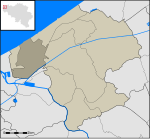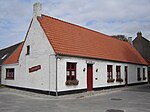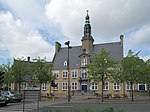Nieuwpoort, Belgium

Nieuwpoort ( NEW-port, Dutch: [ˈniupoːrt] ; West Flemish: Nieuwpôort; French: Nieuport [njøpɔʁ]) is a city and municipality located in Flanders, one of the three regions of Belgium, in the province of West Flanders. The municipality comprises the town of Nieuwpoort proper, as well as Ramskapelle and Sint-Joris. On 1 January 2008, Nieuwpoort had a total population of 11,062. Its land area is 31.00 km² which gives a population density of 350 inhabitants per km². The current mayor of Nieuwpoort is Geert Vanden Broucke (CD&V) In Nieuwpoort, the Yser flows into the North Sea. It was also the home of a statue created by Jan Fabre called Searching for Utopia. The Stadshalle Grain Hall (market hall) with its belfry was inscribed on the UNESCO World Heritage List in 1999 as part of the Belfries of Belgium and France site, owing to its historical civic (not religious) importance and its architecture.
Excerpt from the Wikipedia article Nieuwpoort, Belgium (License: CC BY-SA 3.0, Authors, Images).Nieuwpoort, Belgium
Kinderlaan,
Geographical coordinates (GPS) Address Nearby Places Show on map
Geographical coordinates (GPS)
| Latitude | Longitude |
|---|---|
| N 51.116666666667 ° | E 2.75 ° |
Address
Kinderlaan
Kinderlaan
8670
West Flanders, Belgium
Open on Google Maps










